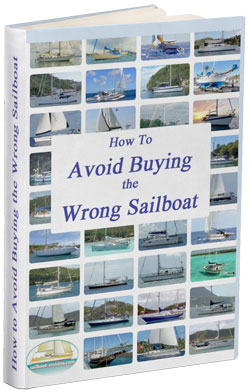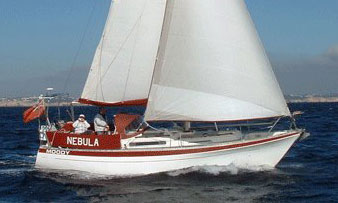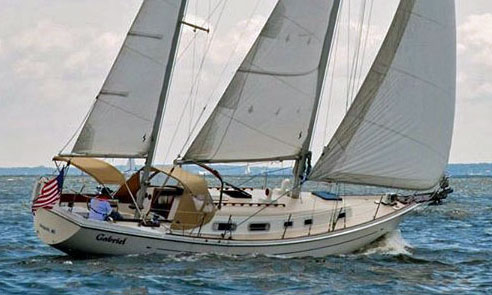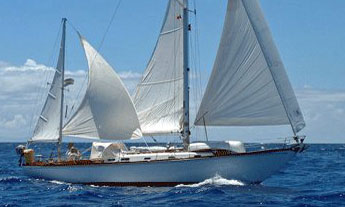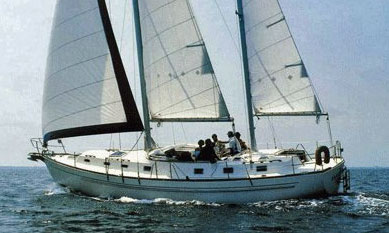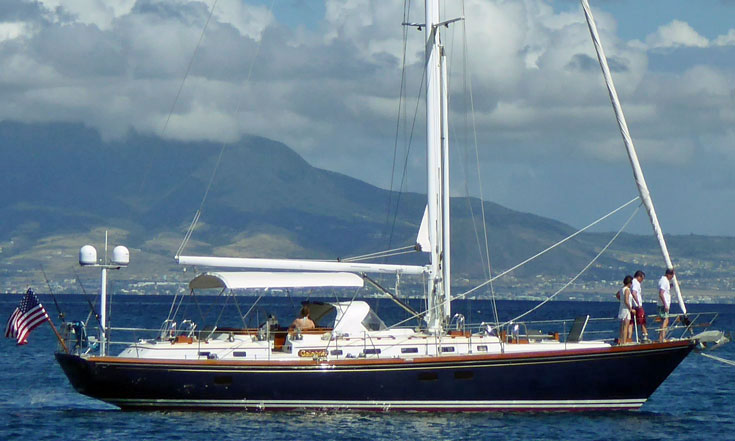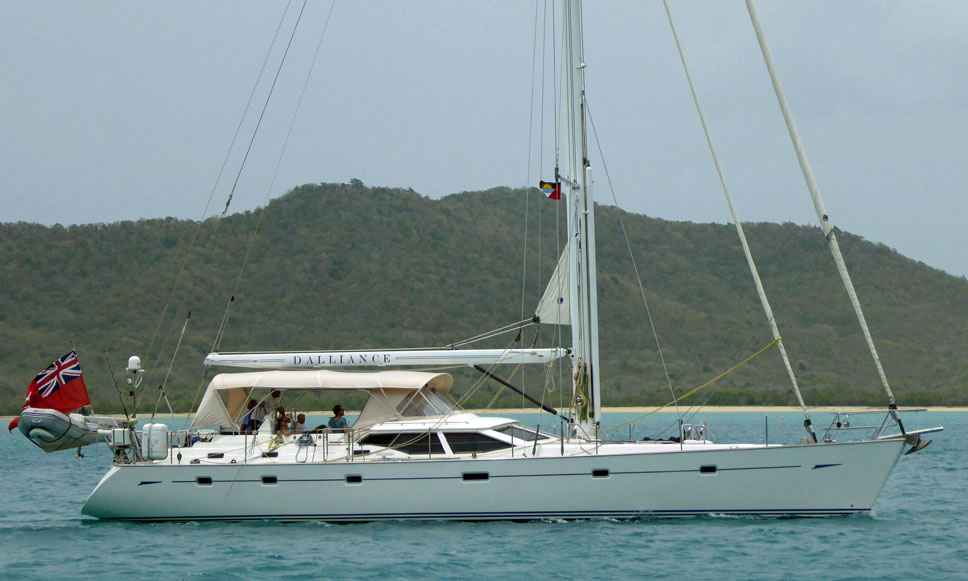- Home
- Sailboats 50'-55'
- Alden 50
The Alden 50 Sailboat
Specs & Key Performance Indicators
The Alden 50 sailboat was designed by Alden Yachts and manufactured by Alden Yachts (USA) throughout the years 1996 to 1998.
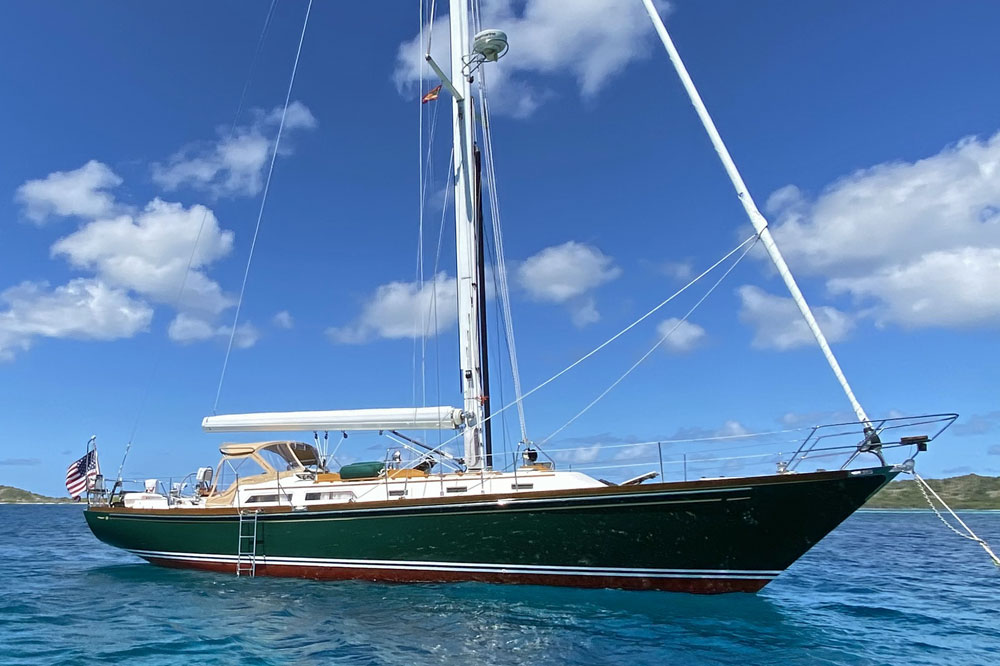 An Alden 50
An Alden 50Published Specification for the Alden 50
Keel & Rudder Configuration: Stub keel with centreboard, and skeg-hung rudder.
Hull Material: GRP (Fibreglass)
Length Overall*: 50'4" (15.3 m)
Waterline Length*: 37'1" (11.3 m)
Beam*: 3'6" (4.1 m)
Draft*: max 10'4" (3.2 m), min 5'6" (1.7 m)
Rig Type: Masthead sloop.
Displacement*: 38,000 lbs (17,237 kg)
Ballast*: 11,500 lbs (5,216 kg)
Sail Area*:
1,092.07 ft² (101.46 m²)
Water Tank Capacity: Not known
Fuel Tank Capacity: Not known
Hull Speed: 8.16 kn
Designer: Alden Yachts
Builder: Alden Yachts (USA)
Year First Built: 1996
Year Last Built: 1998
Number Built: 3
* Used to derive the design ratios referred to later in this article - here's how they're calculated...
Design Options & Alternatives
The Alden 50 was a masthead sloop. However, broadly for Alden sailboats, buyers could sometimes choose between cutter or ketch rigs for various models. It is not clear if these options were available for the specific Alden 50 model produced from 1996-1998.
There is a distinct "Alden 50 (Cheoy Lee)" model that was first built in 1967, indicating a different builder and earlier design, which could be considered an "alternative version" in a broader sense of Alden 50-foot designs. This suggests Alden had other 50-foot designs, but not necessarily alternative versions of the 1996-1998 model.
Sail Areas & Rig Dimensions
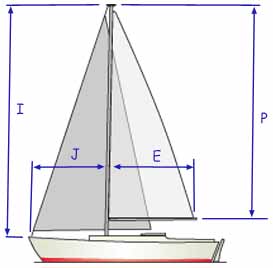 Sail Areas & Rig Dimensions
Sail Areas & Rig DimensionsSail Areas
- Mainsail Area: 515 ft² (47.85 m²)
- 100% Foretriangle Area: 577 ft² (53.61 m²)
- Total Sail Area: 1,092 ft² (101.46 m²)
Rig Dimensions
- I (foretriangle height): 59.80 ft (18.23 m)
- J (foretriangle base): 19.30 ft (5.88 m)
- P (main luff): 51.50 ft (15.70 m)
- E (main foot): 20.00 ft (6.10 m)
Published Design Ratios
The Key Performance Indicators (KPIs)
The key design ratios for the Alden 50 are:
- Sail Area/Displacement (SA/D): 15.5
- Displacement/Length (D/L): 333
- Ballast/Displacement Ratio (B/D): 42.9%
- Capsize Screening Formula (CSF): 1.6
- Motion Comfort Ratio (MCR): 44.7
Theoretical Sailing Characteristics
Based on its design ratios, the Alden 50 exhibits the theoretical characteristics of a heavy displacement offshore cruising boat, prioritizing stability, comfort, and seaworthiness over light-air performance or racing speed.
- Sail Area/Displacement Ratio (SA/D): 15.5 An SA/D ratio of 15.5 suggests that the Alden 50 would be considered under-powered in lighter winds. This means it will require a good breeze to get moving and reach its hull speed. In conditions with insufficient wind, motor-sailing would likely be necessary to maintain progress. This ratio indicates it's not designed for high performance in light air.
- Ballast/Displacement Ratio (B/D): 42.9% A B/D ratio of 42.9% is considered high (above 40%). This indicates that the Alden 50 will be a stiff and powerful boat. It means the boat will stand up well to its canvas in strong winds, resisting heel and maintaining its course. This contributes significantly to its stability and ability to power through waves in heavy weather.
- Displacement/Length Ratio (D/L): 333 A D/L ratio of 333 places the Alden 50 firmly in the heavy displacement category (275 to 350). This suggests a boat designed for robust offshore cruising. Heavy displacement boats are known for their ability to carry significant loads (cruising gear, supplies) with minimal impact on their waterline and performance. While not ideal for coastal sailing where agility and light-air speed might be desired, it excels in offshore passages, providing a stable and comfortable ride in challenging conditions.
- Comfort Ratio (Ted Brewer's): 44.7 A Comfort Ratio of 44.7 falls within the range of 40 to 50, indicating a heavy offshore boat. This ratio is an indicator of the motion comfort in a seaway. A higher comfort ratio generally means a more damped motion, with less abrupt pitching and rolling. For the Alden 50, this implies that the crew would experience a relatively comfortable ride, even in rough seas, making it well-suited for extended voyages where crew comfort is paramount.
- Capsize Screening Formula (CSF): 1.6 A CSF of 1.6 is well below the 2.0 threshold, indicating that the Alden 50 is better suited for ocean passages and has a reduced vulnerability to capsizing. This ratio is primarily a measure of initial stability and the boat's ability to resist capsize in rough conditions. A lower number signifies greater resistance to capsize, making it a safer choice for bluewater sailing.
In summary, the Alden 50 is theoretically a very stable, comfortable, and seaworthy offshore cruising boat, capable of handling challenging conditions with good resistance to capsizing. Its heavy displacement and high ballast ratio suggest it will power through waves effectively and maintain a steady course. However, its lower sail area to displacement ratio indicates it will be less lively in light winds and may require engine assistance in such conditions.
But the Design Ratios Don't Tell the Whole Story...
While design ratios offer a valuable quantitative snapshot of a sailboat's theoretical characteristics, they have several significant limitations in fully defining a sailboat's actual sailing performance and feel:
1. Simplification of Complex Hydrodynamics and Aerodynamics:
- 2D vs. 3D Reality: Ratios are typically based on simple two-dimensional measurements (length, beam, draft, displacement, sail area) and don't account for the complex three-dimensional hull shape, keel and rudder foils, or the actual sail plan and its efficiency.
- Hull Form Nuances: For example, two boats can have the same D/L ratio but vastly different hull shapes (e.g., fine entry vs. bluff bow, U-shaped vs. V-shaped sections, full vs. canoe sterns). These shape differences dramatically affect wave-making resistance, pitching motion, and tracking ability, which ratios don't capture.
- Keel and Rudder Design: The specific design of the keel (e.g., fin, full, wing, bulb) and rudder (e.g., spade, skeg-hung) has a major impact on lateral resistance, maneuverability, and upwind performance. A stub keel with a centerboard, as on the Alden 50, offers variable draft but might introduce more drag than a fixed fin keel when down, a nuance not captured by draft alone.
- Sail Plan Efficiency: Sail Area/Displacement only considers total sail area. It doesn't account for aspect ratio of the sails, sail shape, sail material, or the efficiency of the rigging (e.g., mast bend, traveler system, sheeting angles), which all influence how effectively the sail area translates into forward motion.
2. Ignores Construction and Weight Distribution:
- Construction Material and Stiffness: Ratios don't tell you about the boat's construction quality, stiffness of the hull, or integrity of the mast and rigging. A poorly built boat, regardless of its ratios, will perform poorly and be less safe.
- Weight Distribution (Moment of Inertia): While displacement is accounted for, how that weight is distributed fore-and-aft and athwartships significantly impacts pitching and rolling motions. A boat with heavy ends will pitch more violently, even if its Comfort Ratio is high. This can lead to a less comfortable ride than the ratio might suggest.
- Ballast Distribution: The Ballast/Displacement ratio indicates the proportion of ballast, but not its vertical distribution. A deeper, heavier bulb keel provides more righting moment for the same ballast weight than a shallower, more dispersed ballast.
3. Does Not Account for External Factors or Crew Skill:
- Sea State and Wind Conditions: Ratios are static numbers. They don't predict how a boat will behave in specific wave patterns (e.g., short chop vs. long swells) or turbulent wind conditions.
- Crew Experience and Sail Trim: A skilled crew can coax far better performance out of a "slower" boat, and conversely, an inexperienced crew can make a "fast" boat feel sluggish. Ratios have no way of factoring in human input.
- Loading: The actual displacement and trim of a boat can vary significantly depending on the amount of fuel, water, provisions, and gear carried. These variations can alter the effective D/L and SA/D ratios from their "published" values, impacting performance.
4. Limited Scope of Performance Metrics:
- Pointing Ability and Leeway: Ratios don't directly quantify how well a boat points into the wind or its amount of leeway. These are crucial aspects of sailing performance.
- Maneuverability: How quickly a boat responds to the helm, its turning radius, and its ease of handling in tight spaces (like marinas) are not captured by these ratios.
- Speed Potential is Limited to Hull Speed: While hull speed is an important theoretical limit, it doesn't describe acceleration, or how quickly a boat can reach and maintain that speed in varying conditions. Modern designs often exceed traditional hull speed formulas.
5. Comparative, Not Absolute:
- Design ratios are most useful for comparing similar types of boats rather than providing an absolute measure of a single boat's performance. A boat with a high SA/D is faster relative to its displacement than one with a low SA/D, but that doesn't mean it's an inherently "fast" boat if its D/L is very high.
In conclusion, while design ratios provide a valuable starting point for understanding a sailboat's fundamental design philosophy and general characteristics (e.g., cruiser vs. racer, heavy vs. light displacement, comfortable vs. lively motion), they are oversimplifications. For a true assessment, one needs to consider detailed hull lines, construction methods, specific appendage designs, and real-world performance data from sea trials and owner feedback. They are indicators, not definitive statements, of a boat's ultimate sailing characteristics.
More Specs & Key Performance Indicators for Popular Cruising Boats
Recent Articles
-
Catalina 30 Sailboat Review: Specs, Performance & Buying Guide
Jan 18, 26 07:56 AM
An expert review of the Catalina 30 sailboat. Discover technical specifications, performance ratios, and why this Frank Butler design remains a cruising icon. -
Jeanneau Sun Odyssey 50 Review: Specs, Ratios & Cruising Guide
Jan 17, 26 07:45 AM
A comprehensive review of the Jeanneau Sun Odyssey 50 and 50DS. We analyse the Philippe Briand design, performance ratios, and layout for offshore cruising and liveaboard life. -
Cutter Rig vs Solent Rig: The Ultimate Offshore Sail Plan Guide
Jan 16, 26 01:44 PM
Discover the critical differences between a cutter rig and a solent rig for offshore cruising. Compare performance, heavy weather handling, and retrofitting costs.
